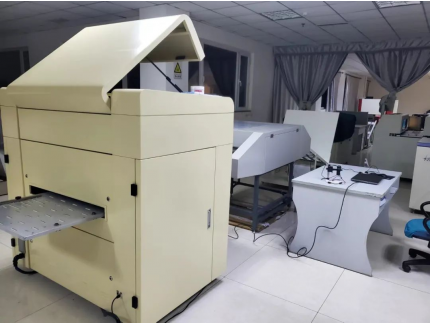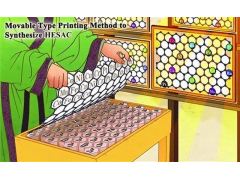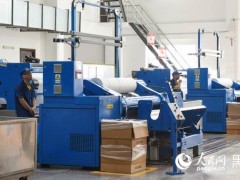【 Watch home 】
Not long ago, I came to Dege County, Ganzi Prefecture, which is located at the border of Sichuan and Tibet, on the "Sichuan-Tibet Line Tea Horse Road Survey" organized by Peking University and Beijing Science Chinese Magazine.
Dege, which means "good place", is the hometown of King Gesar. Gesar is the embodiment of Padmasambhava in the 11th century Tibetan legend. He fought in the army all his life, promoted good and discouraged evil, and became a hero that the Tibetan people were proud of. The epic legend is widely spread.
Dege Printing House, founded in 1729 AD, is a national key cultural relic protection unit, known as "the world's most complete categories, the most unique layout, the most sophisticated engraving, the most exquisite font, the most proofreading, the most well-protected Tibetan traditional block printing museum."
Dege Printing House has always continued the traditional way of printing sutras, between the beginning of spring and the end of autumn, about half a year of engraving sutras. This time we came to Derge, we were lucky to catch the sutra printing season.
I. The Printing House, which lasted 30 years
Dege County Gengqing town is not big, only more than 10,000 people. The narrow, silent valley is lined with Tibetan buildings. Cross the Serqu River, go up along a slightly sloping winding street, the residential houses on both sides suddenly shrink to the edge of the mountain, white pagodas and huge prayer wheel instead of those residential houses, let people feel a strong religious atmosphere. Around the corner, in the hollow of the hill, a maroon building shaped like a temple rose.
This is the famous Dege Printing School.
It seems that the Dege Printing House is not as big as a medium-sized temple. It used to be a temple, called Gengqing Temple, which has gradually evolved from a temple to its present form since the 1940s. Like the Potala Palace in Lhasa, it is a cultural holy place on the Kang-Tibetan Plateau.
The simple and solemn Dege Printing School is a flat-top civil structure building. The printing house is divided into the storage room, the drying room, the washing platform, the Buddhist hall and other areas, which was created in 1729 by the 12th generation of Dege's chieftaincy, Chogi Dambazeren.
According to Ge Xi, deputy director of the Dege County Cultural Tourism Bureau, in today's view, Dege Printing House is not a big project, but in the vast snow field 290 years ago, it is not easy to repair this building. When Chogi Dambazeren, who was 52 years old at the time, presided over the construction of the Dege Printing House, he recruited thousands of Tibetans, leveled the foundation, cut the mountain and cut the wood. After his death at the age of 61, his sons Phuntsotdemba, Solangongpo and Lodzugatso inherited his father's legacy and took over the expansion of the printing house.
I do not know how to explain to posterity when the former Chaiji Danba Zeren was alive, nor do I know what family rules were set, they are like Yu Gong, one after another. Printing house construction process is very hard, up to the Tusi monks, down to the ordinary migrant workers, generation after generation, Lao Zi died there is a son, the son died there is a grandson, or son for father, brother for brother, from black hair to white head, from home to foreign land, from the sun rising to the moon, from the spring sun melting ice to the snow closed the mountain, after 4 generations of Tusi, lasting 30 years, the third floor and the bottom of the grand printing house finally built.
Ii. Preservation of 290,000 printing plates of Tibetan classics
As we climbed the narrow stairs to the second floor of the printing house, the plateau sun shone through the Windows, casting a golden glow across the narrow passageway. In the deep space, standing rows of tall cabinets, above neatly stored a large number of classics, let people respect. It is said that 290,000 Tibetan classics are preserved here, some of which are already isolated.
Up the stairs, in the corridor around the patio, I saw more than a dozen craftsmen and masters working hard to print sutras. They sat in pairs, facing each other, and one of them was responsible for changing the sutras and painting the ink. The inking tool is homemade and looks like a thick stack of cloth stitched together with thread. From day after day of painting, the edges are frayed, more like a soft brush. The cotton wool is more ink absorbing, soft and delicate, and the ink is more uniform, and will not accumulate on the warp plate. The other was responsible for the paper and printing - he moved his body rhythmically back and forth, first placing a piece of paper on the tablet, and then holding a wooden roller with both hands to press the paper back and forth, so that the text was printed.
The process of printing the sutra, in one go, fast and smooth. I noticed that the fastest pair were two 16 - and 17-year-olds wearing red sleeveless "Dugga" (vests). They work very well together, they are very fast, and the handwriting is very clear. One of the teenagers smiled and said that their printed scriptures were always clean, which was a respect for the scriptures and a tribute to the classical documents.
The place was quiet, except for the slight clatter of wood as the plates were being lifted and placed. When they stopped to rest, the craftsmen would talk for a few minutes, also quietly, and no one was loud in the printing house. After the printed scriptures are dried in a ventilated place, they are proofread again and then bundled into a book.
It is understood that each group of artisan masters of the printing house is about 2,400 pieces per day, and they work for about 6 hours a day. All the printers, they don't get paid a dime. They're all volunteers. Most of them are Tibetans who live nearby. At the end of each printing, before the printing plate income warehouse, the printer must carefully wash the ink mud or vermilion on it, and then apply ghee, so as to ensure that the printing plate does not rot for a hundred years.
Three. To lead the apprentice, the process secret
Engraving plate craftsmen have always been trained in the form of teachers and apprentices. All artisans are strictly assessed, and only those who are fully skilled and meticulous in their work can engage in engraving work. Under normal circumstances, skilled artisans can only finish the single-side engraving of a printing plate every day, and can finish the single-side engraving of a painting plate in about 10 days. For example, it took 100 calligraphers three years and 500 artisans five years to complete the engraving of the Ganyur book, which is famous all over Tibet. It is with these fine plates that many important Tibetan cultural contents have been handed down.
"The early Dege Printing House not only printed sutras, but also gathered a group of scholars who studied Tibetan studies. The books of the Dege Printing House are not only beautifully printed, but the 'Dege edition' often represents the rare ones in Tibetan Buddhist texts." Gussie told us.
Dege Printing House, known as the "encyclopaedia of Tibetan culture", "bright cultural pearl in Tibetan areas" and "treasure house of Tibetan culture under the snow mountains" reputation, it and Lhasa Printing House, Lableng Printing House known as the three major Tibetan printing houses, and to a large extent, the first of the houses.
In order to prevent fire, this ancient workshop has not installed electric lights, so the visibility of the library is very poor, and it looks very dark and deep, but if the monks and printers have the hand of God, they can easily find the one they need in the hundreds of thousands of pieces of scripture. These sutras have become part of their bodies. In the dark temple, through the window to see the blue sky outside, but also rise their hearts of light, let the sun and moon rotate, let the cold and summer change, let the face change.
In today's frequent change of various popular cultures, the Dege Printing House is like a thousand-year bodhi in front of the door, absorbing the essence of the sun and moon, quietly growing and luxuriant, supporting the strong shade of history, culture and artisan spirit, and protecting a spiritual garden.
Garze folk culture expert Karma Chan cun said that the Tibetan printing of the Dege Printing House has been using traditional block printing techniques for 290 years, and many of its unique skills are secret.
Roughly speaking, the production of printing plates requires three processes - raw material processing, writing and engraving. From writing to engraving, only proofreading has to go through 12 times, and after printing, it has to go through the last few checks. Therefore, the Buddhist classics and paintings printed by the Dege Printing House enjoy an excellent reputation in Tibetan areas, and have the reputation of "the most standard classic version".
Among the 290,000 printing plates stored in the Dege Printing Institute, there are scriptures, historical records, and painting plates, and 70% of the ancient books in Tibetan culture have been preserved. These plates, the material is very particular, with red leaf birch as the material, every autumn, Tibetans go up the mountain to cut wood, choose straight and knot-free trunk, cut the growth of 100 cm, 10 cm wide, 4 cm thick wood blocks, with a mild fire smoke and bake into the manure tank to retting a winter. The next year, the wood block is taken out, boiled, dried, pushed and planed to make a blank board.
The raw material for paper making is the root of a herb called "ejiao Rujiao". The Dege paper made with it is yellowish in color, thicker and thicker in texture, but the fiber is flexible, not easily broken, strong in water absorption and long in storage.
Since 1979, the printing production process of Dege Printing Institute, in addition to the use of finished ink is no longer hand-mixed ink, other processes are still.
Four. Reproduction of "Block printing"
Xiang Qiuzhuoma, a cultural scholar in Ganzi prefecture, said that when he was a child in his village, the monks used sutras from the Dege Printing House. For the Tibetan compatriots, the scriptures of the Dege Printing House are not only beautiful, but also play a role of blessing. Some people travel long distances to the printing house, not to buy scriptures, but to turn the Ba Palace (workshop) and observe the engraving and printing process. This is also a simple tribute to the culture of collection.
In the past, Tibetans in the east of Dege County had to cross the "first dangerous peak in Sichuan and Tibet" Chouer Mountain to get the Sutra. Chola Mountain pass 5050 meters above sea level, from Manigango began to climb the mountain, trek for several days, the road is difficult, especially in the winter, the ice is like a knife, the wind is hail, the beast is infested, the deep shallow gully is filled with snow, and it will fall during the careless. Now the tunnel through the Chouer Mountain has been opened, the days of walking over the Chouer Mountain are gone forever.
In 1996, Dege Printing House was announced by The State Council as a national key cultural relic protection unit; In 2006, as a traditional skill, "Dege Printing Institute Tibetan block printing skill" was included in the first batch of national intangible cultural heritage representative list.
Chen Baoya, a professor in the Chinese Department of Peking University and one of the people who named the ancient Tea Horse Road that has walked the Yunnan-Tibetan-Sichuan "Great Triangle" for many times, said that the engraving content of the Dege Printing School covers religion, history, science and technology, medicine, mathematics, literature, astronomy, geography, music, Tibetan grammar and other fields. The printing process has maintained the most traditional skills and production methods since the 13th century, all purely manual, and it is very rare to reproduce the "block printing" that has disappeared long ago.
Chinese block printing originated in the late Southern and Northern Dynasties, and was later replaced by movable type printing. More than a thousand years have passed, and printing has developed into the era of computer typesetting and high-speed color printing; However, in the Chinese Dege Printing House, still preserve the ancient block printing technology, the craftsmen in the dozens of subtle processes, with pure heart and technology to produce a book of Sutras, it is not easy, just like the wilderness swamp on the Sichuan-Tibet plateau, reed, cattyma, haloxel, tamarisk, white thorn and other plants, always illuminated by light, thrive and live out their most comfortable appearance.
The documents and books printed by the Printing House have not only been widely disseminated in the vast Tibetan areas of China, but also collected by many museums and research institutions in China, and exported to India, Nepal, Bhutan, Sikkim, Japan and some countries and regions in Southeast Asia, and some important classics have been collected by famous libraries in Asia, the United States and Europe.
With the smell of highland barley, the autumn wind blew slowly from the surging Sequ River, flooded my eyes, and left the time behind. At dusk, a bleak beauty hangs over the plateau, and the air is filled with leisurely Brahma sounds. The setting sun reflected on the red wall of the printing House, showing a kind of holy light. I touched the mani stones with different patterns outside the big wall, and my impetuous heart calmed down...
(Author: Li Guiping Author: West China Metropolis Daily)


